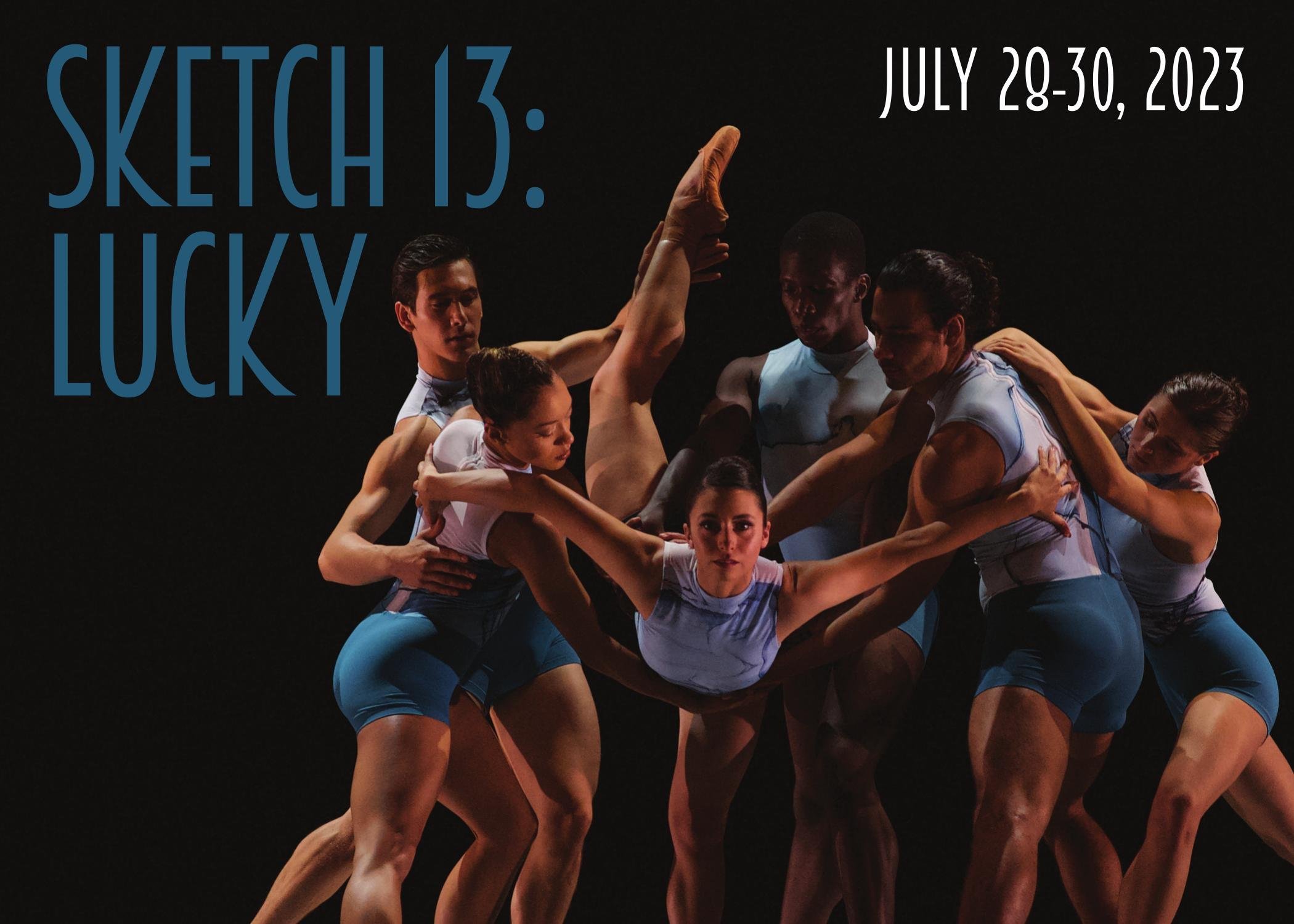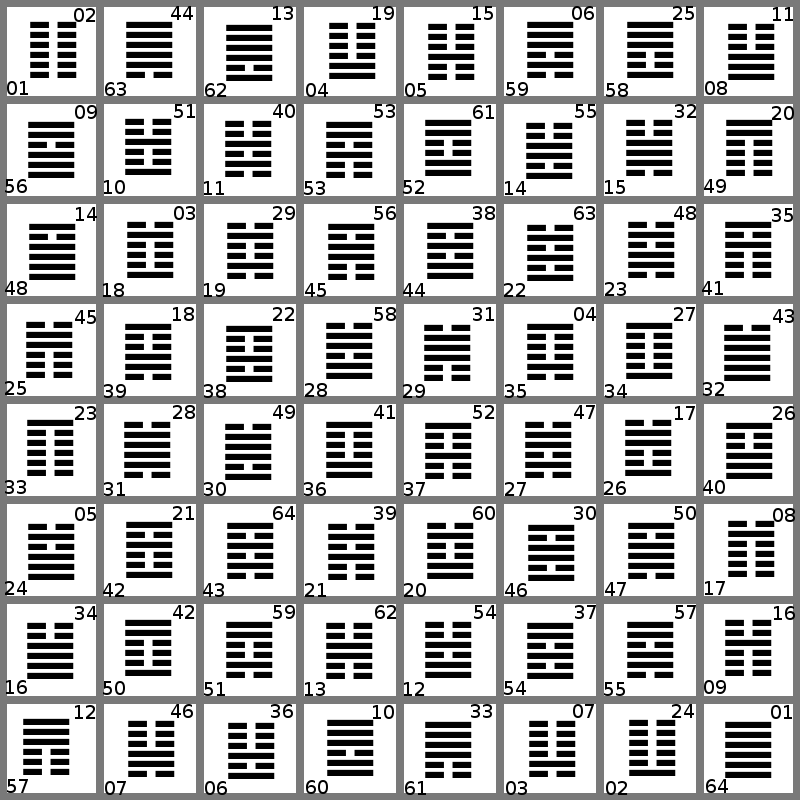SKETCH 13: Lucky challenges four choreographers to bring chance into their process.
Image description: Five dancers support one dancer in the center of a clump, her arms spread wide and leg unfurled behind her head. On a black background, blue text reads: SKETCH 13: LUCKY; white text reads: July 28-30, 2023.
What does it mean to embrace chance? Imagery’s Artistic Director Amy Seiwert has long been intrigued by the theoretical use of chance in artmaking, which she first encountered in Sunrise of the Planetary Dream Collector, a string quartet by pioneering minimalist composer Terry Riley. Seiwert, who reads music and often refers to musical scores in her choreographic process, was confused when Riley’s score didn’t match up with what she was hearing. Instead of a set score, the composer had written a collection of 24 short modules along with instructions for the musicians to “co-compose” their order, dynamics, and length—giving agency to the performers and resulting in a piece that would sound different in any given performance. How could this method be applied to dance?
This initial curiosity opened the door to many more questions and considerations at the heart of dance and dancemaking. For Seiwert, ballet’s tendency to focus on achievement and accomplishment can be hard to shake. By actively embracing chance as part of the choreographic process, she hopes to fuel the kind of generative discomfort that makes honest risk-taking possible. With a balance of trust, vulnerability, and authentic, open communication, she hopes to cultivate an environment where artists can put faith in the creative process, stay in the moment, and let go of expectations.
Now entering its final season, SKETCH 13: Lucky invites its four choreographers—Seiwert, Imagery Artistic Fellow Natasha Adorlee, and guests Hélène Simoneau and Trey McIntyre—to incorporate an element of chance into their process. For each choreographer, the prompt remains open to interpretation as they set out to make their dance. The challenge can be daunting, though using new tools can also be a lot of fun. In their first days of creation, each choreographer took time to explore their approach to chance in collaboration with the dancers. In many ways, the element of chance amplifies the palette of possibilities in this symbiotic creative relationship.
Grace-Anne Powers in rehearsal for Seiwert’s dance. Photo by Robert Suguitan.
Image description: A dancer in black pants, colorful leotard, and pointe shoes takes a wide open stance with her front foot pointed, arms outstretched in front with her palms facing outward, fingers splayed.
Seiwert is using “if-then” equations to puzzle together a collection of interlocking modules in her dance, which she anticipates will have some variability even in performance. With this dance, Seiwert is leaving more in the dancers’ hands than ever before, and is equipping them with new and familiar tools they can use to thrive in their choices. Her initial experiments in rehearsal take the form of structured games that the dancers play together in pairs and small groups, rearranging and manipulating phrase material in planned and improvised ways. They’re actively problem solving to create flexible plans capable of adapting to changing circumstances, a skill that will prove essential in performance. As Seiwert puts it, “Strategic planning is both essential and useless—make a plan and prepare to deviate from it.” In one game, five dancers deconstruct a short dance phrase, but only three can be in motion at any given time. This leads to a live negotiation between movement and stillness, a conversation that requires each dancer to have a finely-tuned sensitivity to their body and the others around them. Coincidences of timing and new coordinations emerge as the dancers get comfortable with being in a mindset of continual discovery. Throughout the process, striking the right balance between order and chaos will allow both Seiwert and the dancers to turn uncertainty into endless possibility.
Kelsey McFalls and Joseph Hernandez in rehearsal for Adorlee's duet. Photo by Robert Suguitan.
Image description: Two dancers captured in a weight-sharing movement: a dancer in a black tank top and pants holds the bent arm of another dancer in a turquoise shirt. Each pulls tension sideways away from the other, their eyes focused and downcast.
Imagery Artistic Fellow Natasha Adorlee, whose background in contemporary dance and multimedia artmaking lends itself to outside-the-box thinking, feels that chance nearly always plays a part in her process, from the challenge of taking new risks to harnessing the unpredictable chemistry between dancers. Chance also shows up as a theme in her duet for SKETCH, which is based on her parents’ first meeting and the role luck had to play in sparking their love. Within this narrative frame, she is interested in exploring the bittersweet influence chance can have in balancing individuality and connectedness in relationships. The duet’s ever-shifting dynamic moves between playfully aggressive passages dense with quick gestures and precise footwork and languid partnering that requires controlled momentum and weight-sharing. With every new encounter, the dancers must be fully present and attentive in every moment to sustain the thread of their connection. In the studio, Adorlee closely observes how SKETCH veterans Kelsey McFalls and Joseph Hernandez interact and problem solve together to find gestures and quirks to weave organically into the dance. This receptivity to the dancers’ personalities makes for a dance that remains open to interpretation—one that can never be danced the same way twice.
Anthony Cannarella in rehearsal for Simoneau’s dance. Photo by Robert Suguitan.
Image description: A dancer in a gray tank kneels in profile, pulling a swath of bright red fabric along the floor.
Hélène Simoneau’s approach leans into the challenges and opportunities chance has to offer, and she is taking full advantage of SKETCH’s laboratory-style approach to collaborative, experimental dancemaking. Chance operations were a part of Simoneau’s compositional training, through which she learned how to employ new methods and tasks to shake up her process and break her habits. For her, chance helps avoid the paralysis of “chasing the muse,” and she prefers to be more playful than strict with her approach. Much like Seiwert, games and tasks shape her initial process: Simoneau photographed herself in twenty poses, which she shared with the dancers to put in any order they’d like, intuitively filling in pathways and transitions to create unique individual phrases. Improvisation also factors into the genesis of her dances: she crafts several short phrases on her own body, pairs the dancers up to learn and interpret one passage, and then has each pair teach their material to others—a process of iterative reinterpretation heavily influenced by chance choices and individualistic qualities. She guides the dancers to experiment with the focus and texture of their movement, finessing tone, rhythm, and scale to make discoveries from the inside out. These methods allow Simoneau to keep from being too “precious” about her movement material, instead using her intuition and sharp eye to incorporate unexpected elements into the dance.
(L-R) Johnathon Hart, Matisse D’Aloisio, and Grace-Anne Powers in rehearsal for McIntyre’s dance. Photo by Robert Suguitan.
Image description: Dancers in rehearsal clothes stand facing forward in a sunlit studio with gray walls. The dancer in the foreground has one hand raised in a signing gesture with an inquiring expression on his face. Two dancers stand behind, preparing to move. Three dancers far in the background face away from the camera.
Trey McIntyre says that chance is ever-present in his dancemaking in the form of “trusting in the moment” and “being attuned to what is” through every step of the creative process. In his dance for SKETCH, he is taking new chances by incorporating American Sign Language (ASL) and spoken elements into his movement vocabulary. As these languages merge, their intelligibility blurs and comes into focus—for McIntyre, dance is a language and dancers are always speaking with meaning, whether recognizable or abstract. It’s this spectrum of intelligibility, and the place ASL occupies on it, that interests the choreographer as a point of departure for his dance. In the studio, Deaf dancer and choreographer Antoine Hunter helps translate McIntyre’s intentions into ASL and give feedback to the dancers on specific gestural and expressive elements. Hand shape and placement, facial expression, and physical dynamics all have subtle implications for meaning, tone, and inflection, which the dancers use to guide and express their choices, even as they sign while navigating complex dance phrases. McIntyre plays with themes of intimacy, communication, and compassion, centered on the telling of secrets. The dancers carry secrets with them throughout the dance, and their sharing asks the audience to consider how it feels to tell a secret. His chance element? Secrets volunteered by audience members, to be read aloud as an improvised score for one section of the dance (consider yourselves duly warned).
You can experience these chances and more in SKETCH 13: Lucky at ODC Theater July 28-30. There’s no telling where chance might lead this cohort of artists, and these first impressions tell me that the results will be fresh and thoroughly unexpected for choreographers, dancers, and audiences alike. While creativity is typically a mix of planned and unplanned factors, the intentional use of chance encourages these artists’ adventurous new explorations. It’s also not unprecedented: modern dance choreographer Merce Cunningham is best known for his experimentation with chance.
For more on the history of chance in dance, take a deep dive as I explore Cunningham’s work and legacy from the inside.














